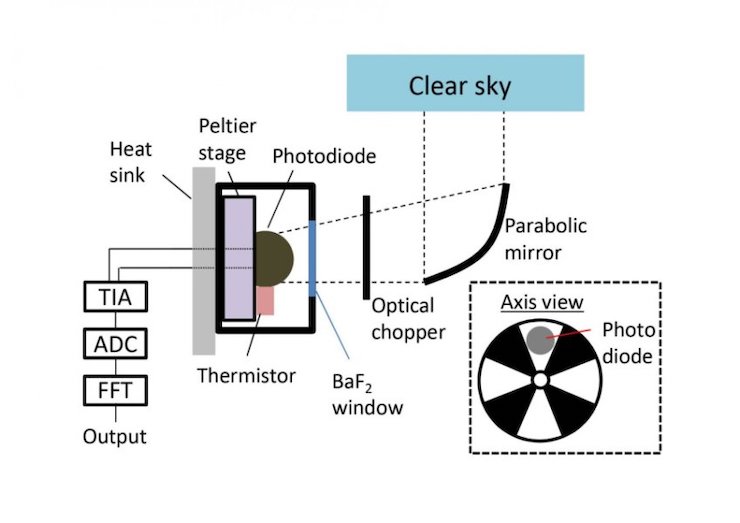Un pannello “solare” per sfruttare il freddo dell’Universo / A "solar" panel to exploit the cold of the Universe
Un pannello “solare” per sfruttare il freddo dell’Universo / A "solar" panel to exploit the cold of the Universe
Segnalato dal Dott. Giuseppe Cotellessa / Reported by Dr. Giuseppe Cotellessa
Un pannello “solare” per produrre energia, ma al buio. Sembra un controsenso, ma è invece il frutto del lavoro di un gruppo di ricerca dell’American Institute of Physics (AIP) pubblicato su Applied Physics Letters. Utilizzando le stesse basi teoriche della produzione di energia solare, infatti, i ricercatori hanno messo a punto un dispositivo capace di sfruttare la differenza di temperatura esistente tra lo Spazio profondo e la superficie terrestre.
Il pannello “solare”
Il dispositivo in questione si basa sul principio dell’illuminazione negativa: mentre un normale pannello solare è azionato dalle radiazioni luminose che ne colpiscono la superficie, questo strumento funziona in modo diametralmente opposto. È costituito da uno specchio ricurvo, simile a una parabola, in grado di captare il trasferimento delle radiazioni termiche dalla superficie dello specchio stesso (più caldo) verso lo Spazioaperto (più freddo) e indirizzarlo verso un fotodiodo che, sulla base di questo gradiente, genera corrente elettrica.
Per ora la quantità di energia prodotta è di appena 64 nW per metro quadrato: è poco ma, come riporta Masashi Ono, uno degli autori, “la quantità di energia che possiamo generare con questa metodologia è, al momento, molto inferiore alle sue potenzialità teoriche”. Infatti, considerando che la temperatura dello Spazio profondo si approssima allo zero assoluto (-270°C), gli autori, proseguendo con gli studi, sperano di poter sfruttare sempre più efficacemente questa enorme differenza di temperatura tra l’Universo ed il nostro Pianeta.

Prospettive future
L’evoluzione tecnologica di questo prototipo potrebbe però condurre anche ad applicazioni più “terrene”; basti pensare a quanto calore viene disperso durante il funzionamento di macchinari industriali. Diverse sono le ricerche volte a comprendere come trasformare il calore dissipato in energia elettrica. Secondo gli autori, con i dovuti adattamenti, questo dispositivo potrebbe essere applicato anche a questo scenario.
ENGLISH
A "solar" panel to produce energy but in the dark. It seems a contradiction but is instead the fruit of the work of a research group of the American Institute of Physics (AIP) published in Applied Physics Letters. Using the same theoretical bases of solar energy production, in fact, researchers have developed a device capable of exploiting the difference in temperature between the deep space and the earth's surface.
The "solar" panel
The device in question is based on the principle of negative lighting: while a normal solar panel is operated by light radiations that strike the surface, this instrument works in a diametrically opposite way. It consists of a curved mirror, similar to a parabola, capable of picking up the transfer of thermal radiation from the surface of the mirror itself (warmer) towards the open space (colder) and directing it towards a photodiode which, on the basis of this gradient, generates electricity.
For now, the amount of energy produced is just 64 nW per square meter: it is little but, as reported by Masashi Ono, one of the authors, “the amount of energy we can generate with this methodology is, at the moment, much lower than its potential theoretical. " In fact, considering that the temperature of the deep space approaches the absolute zero (-270 ° C), the authors, continuing with the studies, hope to be able to exploit ever more effectively this enormous temperature difference between the Universe and our Planet.
Future prospects
However, the technological evolution of this prototype could also lead to more "earthly" applications; just think of how much heat is lost during the operation of industrial machinery. There are several studies aimed at understanding how to transform heat dissipated into electricity. According to the authors, with the necessary adaptations, this device could also be applied to this scenario.
Da:




Commenti
Posta un commento